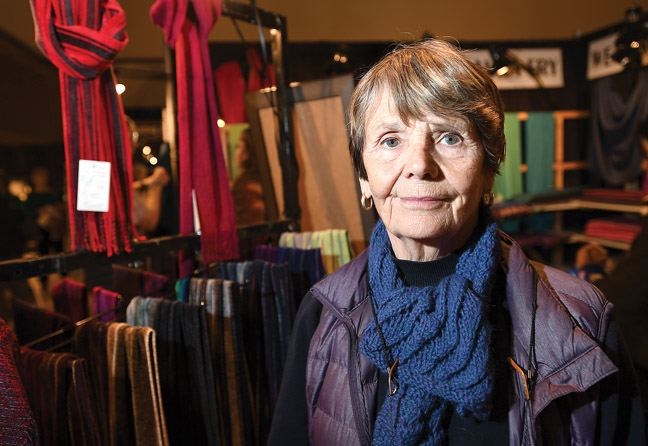The support for the arts was so big in 1976 that it was dangerous.
That was the first year the Community Arts Council ever held Studio Fair. They did it at their headquarters, Studio 2880 on 15th Avenue, and the crowds poured in for the artisan show and sale.
"It was a madhouse. It was dangerous, to be fully honest, so we had to move it. It went to the old Civic Centre after that," said Geri Fletcher, largely credited with inventing Studio Fair. She served for many years on the CAC board, 15 of them as chair, but back then she was new on the staff and it was her job to co-ordinate the fundraising event. She is thrilled to attend this year to watch the big arts show and sale turn 40.
Longtime city councillor Shirley Gratton was a member of the Spinners & Weavers Guild, one of the resident arts organizations that operated from Studio 2880 (and still does). She remembers the mayhem.
"It was so jam-packed in there, right away, that if there'd been a fire we would have all died," Gratton said. "Dads had to carry the kids on their shoulders, it was so crowded. We knew we could move it to the old Civic Centre, we could just tell the numbers were there for the bigger place. It was just an all-local show then, but when we moved to the Civic Centre it opened up the options for having out of town artists alongside the best local ones. It showed everyone that we could stack up with anybody."
Fletcher said having the all-local arts show had its benefits, but opening it up to the rest of Canada also had its benefits. It was a bigger draw, so more customers came to see all the artists. It also gave local artists and their audiences a chance to see that local work was absolutely national calibre.
"It was always juried," said Fletcher.
"We always wanted a balance of crafts - we never wanted 10 jewelers and only two woodworkers. After that, the jury was there for getting the best of those disciplines. Then there was a point system on your location, so the more local you were the higher your points were, but you still had to score the points for quality."
"It grew, it evolved. I saw your (Citizen) article (on Friday) on the virtual reality component that'll be there this year, and that's what Studio Fair has always been about: growing and taking new directions. Showing art for what it is. You have to, if you are to survive 40 years."
The first edition of Studio Fair was held in the summer, but seeing the success of autumn arts and craft fairs convinced the Community Arts Council to set up shop on the threshold of the Christmas shopping season. It has remained a November event ever since.
For several years, the arts council provided physical booths made of wood for each participating artist, but that was too confining and impersonal for the artists and too unwieldy for the volunteer-run organization. It was streamlined so that order and fairness was in place but vendor expression could also be provided.
"We had to try things, we had to evolve, but there were complaints all along the way. Whenever there's change, you're going to get complaints," Fletcher remembered. "That was OK, most of the complaining was about something reasonable or practical, something we could address. It made for a better Studio Fair."
Another impact Fletcher noticed from the early days of the event was the layered duty it was doing for the local economy. First of all, the money spent on the work of an artist doesn't just provide the amount of the profit margin to the vendor. If you buy a sweater from a boutique, the shopkeeper only gets to keep the markup hidden in the price tag. When you buy something from the creator themselves, you are paying them the full amount of the price tag minus only the tools and materials.
Those tools and materials are largely purchased inside the artist's own community, so that, too, flows quickly into the local economy.
"Besides the artisans, I know many people who come from towns around the north just for Studio Fair, so the local economy in general is also boosted by this event in that way, too. It's a very important event for a number of reasons," Fletcher said.
The event is on now at the Prince George Civic Centre today and Sunday. Admission is $5 (children under 12 are free). There are artistic items to see and purchase spanning the gamut from pottery to paintings, from screenprinting to photography, from clothing to cuisine, and made from almost every natural material under the sun. There are displays and demonstrations, live art being created in front of you, and a roomful of artistic vendors who love to talk about how they made their unique creations.
An event only being held for the 2016 edition - this special year only - is a community party on the Saturday. Starting at 11 a.m., a large cake will be available courtesy of the Community Arts Council and Studio Fair anniversary sponsor Royal LePage.



